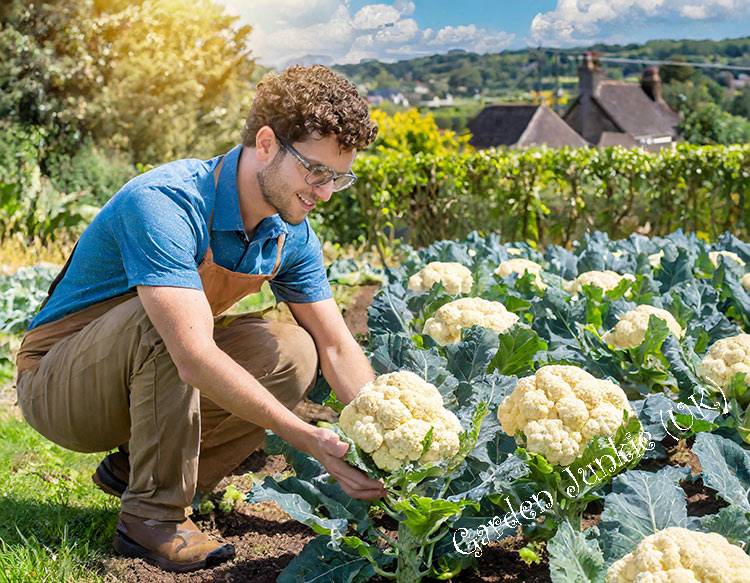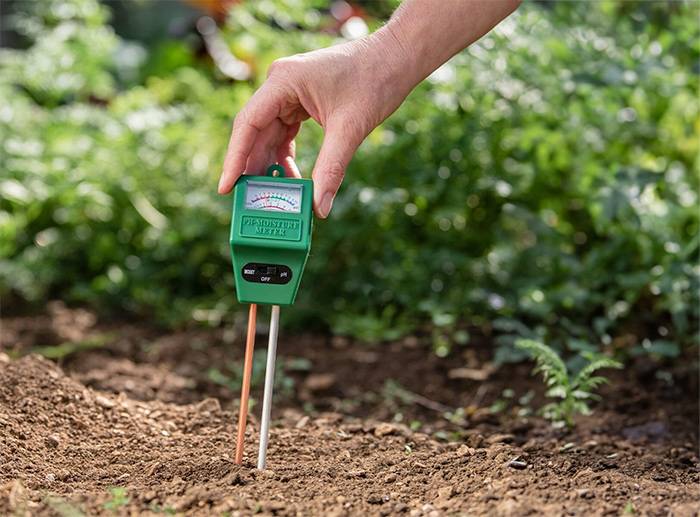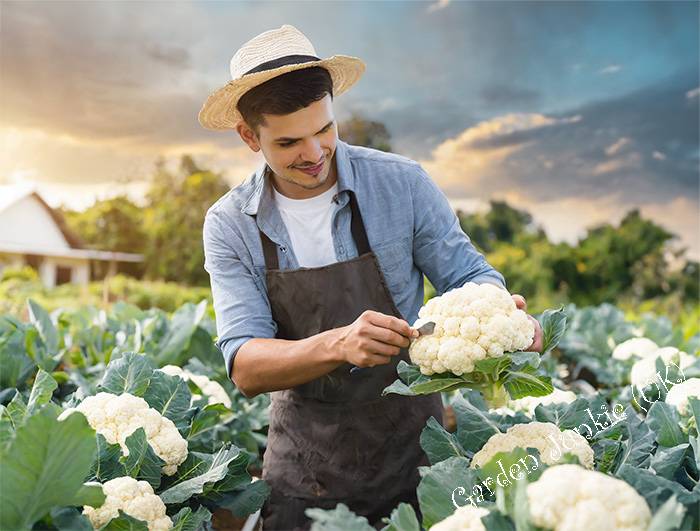Beautiful Plants For Your Interior

How to Grow Cauliflower in the UK: A Comprehensive Guide
Growing cauliflower in the UK can be a rewarding experience for gardeners of all levels. However, many of us, especially those new to gardens and gardening have little or no knowledge of how to grow cauliflower. This post aims to put that right for those vegetable gardeners amongst us.
Cauliflowers are a brassica family member known for their delicious flavour and versatility in cooking. Anyone can grow their cauliflower crop with the right soil, planting time, and a little plant care.
When it comes to planting cauliflower in the UK, choosing a site with ‘full sun’ exposure and well-draining soil is important. Cauliflowers prefer soil that is rich in organic matter, so adding compost or well-rotted manure to the soil before planting can help to improve soil quality. We will discuss soil preparation in more detail later in this post.
In addition, it is recommended to plant cauliflowers in a location that has not had brassica crops planted in the last two years. More about this later in the post.
Choosing the Right Cauliflower Varieties

How to Grow Cauliflower in The UK: Choosing The Right Variety of Cauliflower is Crucial For a Successful Harvest
When it comes to growing cauliflower in the UK, choosing the right variety is crucial for a successful harvest. Here are some things to consider when selecting cauliflower varieties for your garden.
Understanding Different Varieties
Cauliflower varieties can vary in size, shape, and colour. Some popular varieties include ‘All the Year Round‘, which is a reliable and versatile variety that can be planted in both summer and autumn. Another popular variety is Romanesco, which has a unique appearance with its spiral-shaped florets. It is a summer variety that requires a longer growing season.
Other varieties to consider include Snowball, which produces large, whiteheads, and Violetto, which has a purple tint to its florets. It is important to research different varieties and their specific growing requirements to ensure a successful harvest.
Seasonal Considerations for Planting Cauliflower
The timing for the ‘planting’ of UK cauliflower varieties is also important for a successful harvest. Some varieties, such as ‘All the Year Round’, as we mentioned above can be planted in both summer and autumn. However, other varieties, such as Romanesco, are summer varieties and require a longer growing season of around 5-6 months.
If growing from seed, for example, Romanesco should be started in late Spring with the ‘heads’ (curds) ready to be harvested in Autumn from September (6+/- months) onwards. Whereas ‘All Year Round’ can be sown in October in a cold frame or similar, planted out in March, and the ‘heads’ cut in June and or sowed from February to April, and cut the heads late June to September (5+/- months).
It is also important to consider the climate and weather conditions in your area when selecting cauliflower varieties and planting them. In general, cauliflower prefers cool temperatures (between 10 – 21°C or 50°F – 70°) and consistent moisture. Planting in the spring or autumn can be ideal for cooler temperatures, while summer planting may require additional care and attention to prevent the plants from drying out.
Overall, selecting the right cauliflower varieties and planting them at the appropriate time can help ensure a successful harvest.
How to Grow Cauliflower in The UK: Sowing Cauliflower Seeds
Growing cauliflower successfully requires healthy soil with the right composition and texture. This section will provide information on how to prepare your soil for optimal cauliflower growth.
Preparing the Soil Well In Advance For Cauliflower Growth
When you get to the time for planting Cauliflowers ‘out’ in your garden or allotment please be aware of a few important points. Cauliflowers prefer rich, deep fertile soil that is firm but moisture-retentive. However, the soil should be well-draining as cauliflowers need regular watering, particularly during the warmer months.
The soil should have plenty of organic matter, such as well-rotted compost or horse manure, mixed in to provide the necessary nutrients for the new plants. Try to mix in a few buckets full of this compost or manure per m2/sq yard of ground. This ground/soil preparation should ideally be undertaken during the ‘previous’ planting season, to allow for the soil to settle and nutrients to mix for the growing season to come.
It should also be noted at this point that in the area/spot you have chosen to grow your cauliflower, you shouldn’t have grown cauliflowers or other brassicas ie.. cabbage, and or Brussel sprouts for example, in that area/spot for at least 2-3 years previously, this ‘break’ or ‘rotation’ ‘helps to reduce the risk of certain soil-borne diseases and the continued extraction of nutrients that brassicas generally need.. Read More about crop rotation.
Therefore, it is important to prepare the soil well in advance before planting as mentioned above, as this will help to ensure healthy growth and a good harvest. You can check out our post on improving soil quality and soil preparation which will provide additional information about soil quality.
Optimising pH Levels for Cauliflowers
Cauliflowers grow best in soil with a pH range of around 6.5 to 7.5. Add lime to raise the pH level if the soil is too acidic. If the soil is too alkaline, add elemental sulphur to lower the pH level. It is important to test the soil pH before planting to ensure that the soil conditions are optimal for cauliflower growth. Check out my posts on soil pH and improving soil quality (link above) to get you off to a good start.
In summary, preparing the soil for cauliflower growth requires a good understanding of soil composition and texture, as well as the pH level of the soil. By following the guidelines provided in our various posts, gardeners can ensure that their cauliflower plants have the best possible chance of success.

How to Grow Cauliflower in The UK: Ensure your soil pH is correct before planting cauliflower, thus ensuring optimum growth
Spring is Here, So Let’s Get Started
In terms of planting time, it is best to sow your chosen cauliflower seeds indoors in early spring and transplant the seedlings outdoors once the threat of frost has passed. Alternatively, you can sow seeds directly in the ground in late spring or early summer, depending on your chosen variety. Regular watering and fertilising will help to ensure healthy growth, and pest control measures may be necessary to protect the crop from cabbage root flies and other garden pests.
Starting Cauliflowers Indoors
Starting cauliflower seeds indoors is a great way to get a head start on the growing season. Sow the seeds in trays or modules filled with good-quality seed compost. Place the trays on a sunny windowsill or in a windowsill-heated propagator or heat mat to encourage germination.
Once the seedlings have emerged, move them to a cooler, well-lit area to prevent them from becoming leggy. Keep the compost moist but not waterlogged. When the seedlings have grown to around 2in (5cm) tall, they can be transplanted into larger pots or modules to grow on.
Transplanting to the Garden
When the cauliflower seedlings are around 6 weeks old and have developed a strong root system, they can be transplanted into the garden or allotment in the spot you previously prepared as we detailed above.
Before planting out though, further, prepare the soil by removing any weeds and breaking up any clumps of soil. Dig a hole for each seedling, making sure that the hole is deep enough to accommodate the root ball.
Carefully remove the seedlings from their pots or modules, taking care not to damage the delicate roots. Plant them out at a spacing of around 24in (60cm) apart in rows that are 2.5ft (76cm) apart. Water the seedlings well after planting.
By following these tips, you can successfully grow cauliflower from seed in the UK. With a little care and attention, you can enjoy a bountiful harvest of delicious and nutritious cauliflower heads in the months to come.
Caring for Cauliflower Plants
Growing healthy and productive cauliflower plants requires proper care. Here are some of our useful tips on how to care for your cauliflower plants:
Watering and Feeding
Cauliflower plants need to be well watered and fed to ensure healthy growth. Water your plants regularly, especially during dry spells, and keep the soil moist. Avoid overwatering, as this can lead to root rot and other diseases.
Feeding your plants with a balanced fertiliser will help promote healthy growth and improve the quality of your cauliflower heads. Use a nitrogen-rich fertiliser like Elixir Gardens High Nitrogen Fertiliser during the early stages of growth, and switch to a phosphorus-rich fertiliser, like Westland GF6279 Superphosphate Fertiliser during the later stages.
Protecting from Pests and Diseases
Cauliflower plants are susceptible to a range of pests and diseases, including cabbage root flies, caterpillars, clubroot, pigeons, cabbage white butterflies, and aphids. Here are some of our tips on how to protect your plants from these threats:
- Mulch around the base of your plants with organic matter such as compost or straw. This will help retain moisture in the soil and suppress weeds, while also providing a barrier against pests such as cabbage root flies.
- Use netting or fleece to protect your plants from pigeons and cabbage white butterflies. These pests can damage the leaves and heads of your plants, reducing their yield and quality.
- Watch out for signs of caterpillars and aphids, which can quickly infest your plants. Use an insecticidal spray or soap to control these pests, or try introducing natural predators such as ladybirds and lacewings. Consider ‘Companion Planting‘ different plants to help avoid disease and improve your soil.
- If your plants are affected by clubroot, which causes stunted growth and yellowing leaves, remove and dispose of the affected plants and avoid planting brassicas in the same soil for at least three years.
By following these useful tips, you can ensure that your cauliflower plants stay healthy and productive, providing you with a bountiful harvest of delicious and nutritious vegetables.
Harvesting and Using Your Cauliflowers
Knowing When to Harvest
The maturity of cauliflower is determined by the size and appearance of the ‘curds’ (The dense, mounded heads of cauliflower) or flower heads. The curds should be white, firm, and compact with no signs of yellowing or browning. When the curds reach a size of around 6-8 in (15-20cm) in diameter, it’s time to harvest them. However, if you prefer smaller curds, you can harvest them earlier.
It’s important to harvest the cauliflower before the ‘curds’ begin to separate and the florets start to open up. Once the curds have separated, the cauliflower will no longer be as appetising. To harvest, use a sharp knife to cut the cauliflower head from the stem, leaving a few of the outer leaves attached to protect the head.

How to Grow Cauliflower in The UK: Before Harvesting Cauliflower Heads Should be White, Firm, and Compact With no Signs of Yellowing or Browning.
Storing and Cooking Cauliflowers
After harvesting, store the cauliflower in the refrigerator to keep it fresh. It’s best to use the cauliflower within a week or so of harvesting for the best flavour and texture. If you have more cauliflower than you can use, you can freeze it for later use.
Cauliflower can be cooked in a variety of ways, including roasting, boiling, and steaming. It can be used in a variety of recipes, including soups, stews, and stir-fries. For a simple side dish, we roast cauliflower with olive oil, salt, and pepper until it’s golden brown.
FAQ’s
What Are The Best Companion Plants For Cauliflower?
Cauliflower can be planted alongside other vegetables such as beans, Peas, and Tyyme. However, it’s best to avoid planting cauliflower near strawberries or tomatoes as companion plants.
How Can I Protect Cauliflowers From Frost?
If frost is forecast, protect cauliflower heads by folding the large leaves over the ‘curds’ or covering the plants with horticultural fleece or cloches to prevent damage.
How Do I Prevent Cauliflower From Turning Brown or Yellow?
To prevent discolouration, protect the cauliflower heads by tying the outer leaves over the developing curd. This protects the ‘curd’ from sunlight, preventing it from turning brown or yellow.
Conclusion
Growing cauliflower in the UK requires as we pointed out careful attention to soil preparation, planting, watering, and pest control. It is important to choose a suitable location with well-drained, fertile soil and to plant cauliflower at the right time, typically in late spring or early summer depending on the variety chosen.
Regular watering, especially during dry periods, is essential for healthy growth. Additionally, protecting the plants from common pests such as aphids and caterpillars is crucial for a successful harvest. By following our useful guidelines, you can successfully grow cauliflower in the UK and enjoy a bountiful harvest.
